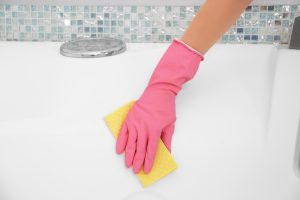How to Clean Your Walk-in Tub

*Updated June 10th, 2025
Investing in a walk-in tub is more than just adding a luxury feature to your bathroom—it’s an investment in your health, safety, and overall quality of life. Walk-in tubs provide increased accessibility, comfort, and peace of mind, making them an ideal choice for individuals with mobility challenges or those looking to age in place. Beyond the personal benefits, a well-maintained walk-in bath can enhance your home’s value, especially in markets where accessibility features are highly desirable among older homebuyers or individuals with special needs.
However, to ensure your walk-in tub stays a valuable asset and functions optimally for years to come, regular cleaning and maintenance are essential. Proper care not only preserves the surface of your tub’s appearance but also prevents mold, mildew, and mineral buildup that can affect its performance. In this guide, we’ll walk you through the best practices to clean your walk-in tub, helping you maintain its longevity, hygiene, and aesthetic appeal.
General Walk-In Tub Cleaning
Walk-in tub cleaning is the best way to keep your tub in great shape and to make it last longer. When you bathe, the oils and dirt from your body go into the tub. Knowing how to clean your tub after each use, weekly, and monthly will ensure your tub lasts for a long time.
1. Daily Cleaning
If you use the tub, you should clean it. This doesn’t take hours or even require special cleaning materials. Instead, after you shower, rinse the tub with warm water, including the faucet and fixtures. This removes any body oils and dirt that accumulated while you bathed.
It helps if you have a shower wand on the faucet because you can reach all areas of the tub without risking your safety. If not, use a sponge and bucket of warm water to rinse the tub and preserve its condition.
2. Weekly Cleaning
If you use your walk-in tub a couple of times a week, it’s important to know how to deep clean it.
There are two ways to do a weekly clean.
Using Dishwasher Granules
If you have dishwasher granules or low-foaming soap, fill the tub with warm water to the seat level and place 2–3 tablespoons of detergent in it. If your tub has jets, turn on the jets and let them move the detergent around, scrubbing the tub. Let it run for 15 minutes.
If there aren’t any jets, use a sponge and scrub the bathtub to loosen any dirt or oils.
After cleaning, drain the tub and run a new tub of hot water to rinse all surfaces. Again, if the tub has jets, let it run. If not, swish the water around to remove soap and grime.
Finally, drain and wipe it with a soft clean cloth to make it shine.
Using a Non-Abrasive Cleaner
You can also use a non-abrasive tub cleaner, such as a mild dish soap solution or disinfecting wipes.
Use a soft cleaning cloth or sponge to scrub the tub clean. Spray the cleaner, gently scrub, then use the shower wand or water to rinse. Finish by drying the tub with a soft cloth.
3. Monthly Cleaning
Weekly cleaning is helpful, but monthly cleaning with a stronger solution ensures a truly clean walk-in tub.
Follow the same process as above, but add ½ cup of bleach and two tablespoons of dishwasher granules. Fill the tub to a level just above the air jets, but not exceeding the max fill line.
Run the jets for 10–15 minutes, let sit, then run the jets for another 15 minutes. Drain the tub, then refill with clean water and run the jets again to remove any bleach or soap residue.
Wipe down the walk-in tub with a soft cloth for a sparkling clean finish.
Best Cleaning Supplies for Walk-In Tubs
When maintaining a walk-in tub, it’s important to choose the right cleaning materials to avoid damage.
-
Use dishwasher granules or mild dish soap
-
Avoid abrasive wire brushes or harsh sponges
-
Keep glass cleaner on hand for fixtures
-
Use a dedicated toothbrush for buildup around jets or drains
-
Choose soft sponges or microfiber cloths
Stick with gentle products to avoid dulling the surface of your tub.
How Not to Clean Your Walk-In Tub
Never use:
-
Wire brushes
-
Harsh chemicals
-
Products that cause excessive foam or slippery residue
A safe step walk-in tub is designed for safe bathing, so avoiding slippery or sticky cleaners keeps the tub clean and safe.
What if You Scratch Your Walk-In Tub?
Accidents happen. If you scratch the tub, try this:
-
Rinse with warm water
-
Wash with mild detergent and soft cloth
-
Rub with toothpaste, rinse again
-
Use automotive cleaning compound to buff the area
How to Take Care of Your Walk-In Tub
Follow these tips and tricks to keep your walk-in tub in top condition:
-
Only run the jets with water above the jet line
-
Avoid abrasive tools and cleaners
-
Do not add essential oils unless using a designated compartment
-
Wipe hinges with rubbing alcohol weekly
-
Use glass cleaner on faucets
-
Wipe the tub completely dry after each use
Addressing Common Walk-In Tub Cleaning Challenges
Cleaning your walk-in tub isn’t always easy—soap scum, hard water stains, and bath oils can create buildup.
-
For hard water, try vinegar or baking soda
-
To tackle soap scum, use a dish soap and vinegar mix
-
After using oils, rinse with warm water and wipe with mild detergent
In jetted tubs, run warm water with detergent to clean the entire system and purge and clean the tub’s plumbing.
Why It’s Important to Clean a Walk-In Tub Regularly
Cleaning your walk-in tub regularly helps prevent:
-
Mold and mildew
-
Jet clogging
-
Black flakes when run the jets
It also ensures your walk-in tub stays functional and safe. Skipping regular cleaning to keep it in good shape may result in costly repairs or reduced lifespan.
Final Thoughts on Caring for Your Walk-In Tub
Caring for your walk-in tub is essential for both hygiene and safety. With consistent daily cleaning, monthly deep cleaning, and smart product care, you can extend the life of your walk in tub and maintain a high standard of cleanliness.
Whether you own a Safe Step walk-in tub, an American Standard model, or another tub with jets, these maintenance routines will keep your walk-in tub sparkling and your bathtub in tip-top condition.
FAQ
What type of soap can you use on a walk-in tub?
Use dishwasher granules or mild detergent. Avoid anything that foams excessively.
Can you run vinegar through a jetted tub?
Yes. Vinegar can substitute for bleach to clean your walk-in tub’s jets. Just remember to follow the instructions and run the jets thoroughly with clean water after.
Can you use Epsom salt in a walk-in tub?
Yes, in moderation. Clean the walk-in tub immediately after to prevent buildup.
Additional Walk-In Tub Resources
- 8 Tips for Saving Money on a Walk-In Tub
- Are Walk-In Tubs Tax Deductible?
- Guide to Home Modifications: Aging in Place

Anna has over six years of experience in the home services and journalism industries and serves as the Content Manager at MyHomePros.com, specializing in making complex home improvement topics like HVAC, roofing, and plumbing accessible to all. With a bachelor’s degree in journalism from Auburn University, she excels in crafting localized, comprehensive guides that cater to homeowners’ unique needs. Living on both coasts of the United States has equipped her with a distinctive perspective, fueling her passion for turning any house into a cherished home through informed, personalized decision-making.
Connect with top-rated local contractors who can help you with siding, roofing, HVAC, windows, and more. Get free quotes from verified professionals in your area today.








